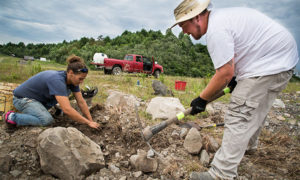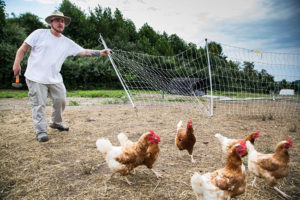On a surface-mine-turned-farm in Mingo County, West Virginia, former coal miner Wilburn Jude plunks down three objects on the bed of his work truck: a piece of coal, a sponge, and a peach.
He’s been tasked with bringing in items that represent his life’s past, present, and future. “This is my heritage right here,” he says, picking up the coal. Since the time of his Irish immigrant great-grandfathers, all the males in his family have been miners.
“Right now I’m a sponge,” he says, pointing to the next object, “learning up here on this job, in school, everywhere, and doing the best I can to change everything around me.”

Crew members Eva Jones and Chris Farley, residents of Mingo County, work the soil. It is compacted, composed of blasted rock, and lacks organic matter.
Then he holds up the peach. “And then my future. I’m going to be a piece of fruit. I’m going to be able to put out good things to help other people.”
Jude works for Refresh Appalachia, a social enterprise that partners with Reclaim Appalachia to convert post-mine lands into productive and profitable agriculture and forestry enterprises that could be scaled up to put significant numbers of people in layoff-riddled Appalachia back to work. When Refresh Appalachia launched in 2015, West Virginia had the lowest workforce participation rate in the nation.
When he’s not doing paid farm work on this reclaimed mine site, Jude is attending community college and receiving life skills training from Refresh. “I’m living the dream. The ground’s a little bit harder than what I anticipated,” he says of the rocky soil beneath his feet, “but we’ll figure it out.”
On this wide, flat expanse of former mountaintop, the August sun is scorching even through the clouds. In the distance, heavy equipment grinds away on a still-active surface mine site—the type of site where some of the Refresh crew members used to work, blowing up what they’re now trying to put back together.

Eventually the hope is to create a closed loop between the animals and plants, where one nourishes the other, cutting down on feed and fertilizer costs.
Crew leaders drive out to an undulating ridge where we can see a 5-acre spread of autumn olive—a tough invasive shrub once heavily seeded on former mine sites as part of coal companies’ reclamation plans. It’s summer 2016, and the crew for this particular Reclaim Appalachia site is awaiting the arrival next week of a forestry mulcher that will remove and chew up the shrubs into wood chips. By the next spring, the clearing will have been replanted by this Refresh crew with over 2,000 berry, pawpaw, and hazelnut seedlings. During my visit, everyone’s clearly excited for the mulcher to arrive.
“It’s almost like a continuous miner head,” explains Nathan Hall, “but instead of mining coal, it’s mulching autumn olives.” Hall is from Eastern Kentucky and worked for a short time as a miner before attending the Yale School of Forestry & Environmental Studies; now he heads up Reclaim Appalachia, which focuses on repurposing mine land.
A few small agriculture projects are on other former surface mines in the area, but Refresh and Reclaim are the only outfits attempting anything of this scale while also operating a job-training project. One crew member, former miner Chris Farley, says he’s stoked to be a part of “the first bunch” to attempt to farm these rugged lands.
“It’s a long-term science project,” says Ben Gilmer, Refresh’s president.
Southern West Virginia nonprofit Coalfield Development runs Refresh, Reclaim, and a family of three other social enterprises. In an environment where finding secure employment is hard, Coalfield offers low-income residents a two- to two-and-a-half-year contract to undergo training in sustainable construction, solar technology, and artisan-based entrepreneurship. Trainees also earn stipends to work on their associate’s degrees and receive life skills mentorship before Coalfield assists them in finding full-time work.
Since 2012, Coalfield Development has created more than 40 on-the-job training positions and grown financial wealth for low-income people by over $3.1 million (calculated in wages, benefits, and savings). At current levels of participation, they project hiring 320 crew members and graduating 215 over the next nine years.
Ultimately, they hope that their model will spread to other parts of Appalachia, creating quality jobs that enable hardworking people to stay and make a living in this economically depressed region, where one in four children live in poverty.
They want to help people such as James Russell, a former coal truck driver who now serves as the site’s crew chief. He gathers me up in a donated pickup truck for the full farm tour, where I meet goats, pigs, and chickens with a dual purpose: to provide food and land management. Their rooting and scratching removes invasive plants and their waste helps build the soil back. Eventually the hope is to create a closed loop between the animals and plants, where one nourishes the other, cutting down on feed and fertilizer costs.
This year during peak season, Refresh expects to sell 2,800 eggs per week to restaurants and produce 1,500 meat birds across all sites. This past spring, the first piglets and kids were born, and crew members harvested honey for the first time. In addition to fruits and nuts, they’re also experimenting with hops, lavender, and greenhouse-grown vegetables.
Besides growing food themselves, Refresh wants to help other startup farmers access markets and technical assistance. This year the organization will offer a mobile poultry-processing trailer to local producers, for example, and then help sell the chickens through their burgeoning food hub.
Refresh recently hired Savanna Lyons, a leader in West Virginia’s sustainable agriculture movement, to manage the hub. The organization wants to provide people with the whole package—step-by-step guides, management documents, and workshops.

The farming model can create jobs that enable hardworking people to stay and make a living in this economically depressed region, where one in four children live in poverty.
They are also getting creative about markets targeting low-income people, thinking about not only where they can sell their fresh product, but also how they can make it accessible to the communities that need it. They are piloting a community supported agriculture program, for example, with a sliding scale that also accepts Supplemental Nutrition Assistance Program benefits.
The Mingo County Redevelopment Authority, a rare and exceptional governmental resource for economic diversification in the coalfields, owns the land and leases it to Refresh free of charge. The authority’s director, Leasha Johnson, says that though many people in the region have already been forced to move away to look for work, “there are a lot of people who are staying and who believe that we can survive this transition.”
That makes projects like Refresh worth the investment, she says. A former land manager for the coal industry, Johnson is one of the only economic development leaders here who will utter once-taboo terms such as “post-coal economy.”
“It’s an uphill battle,” she adds, “from both an acceptance perspective as well as an economic and capital investment perspective.”
Featured photo shows Ben Gilmer, President of Refresh Appalachia. Photo courtesy of Refresh Appalachia.
All other photos are courtesy of YES! / Paul Corbit Brown.
This article by Catherine V. Moore was originally published by YES! Media.
Reprinted with permission.


